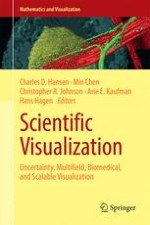Based on the seminar that took place in Dagstuhl, Germany in June 2011, this contributed volume studies the four important topics within the scientific visualization field: uncertainty visualization, multifield visualization, biomedical visualization and scalable visualization.
• Uncertainty visualization deals with uncertain data from simulations or sampled data, uncertainty due to the mathematical processes operating on the data, and uncertainty in the visual representation,
• Multifield visualization addresses the need to depict multiple data at individual locations and the combination of multiple datasets,
• Biomedical is a vast field with select subtopics addressed from scanning methodologies to structural applications to biological applications,
• Scalability in scientific visualization is critical as data grows and computational devices range from hand-held mobile devices to exascale computational platforms.
Scientific Visualization will be useful to practitioners of scientific visualization, students interested in both overview and advanced topics, and those interested in knowing more about the visualization process.
